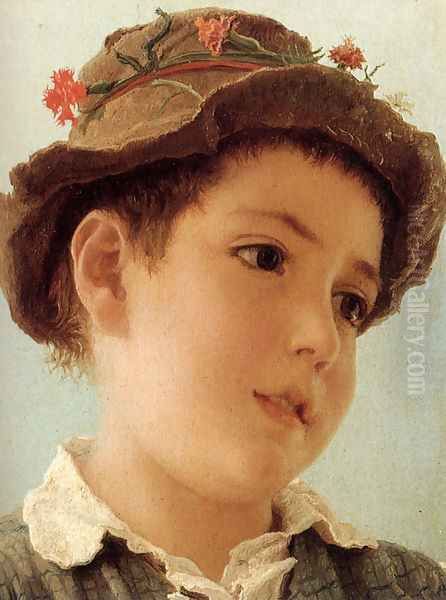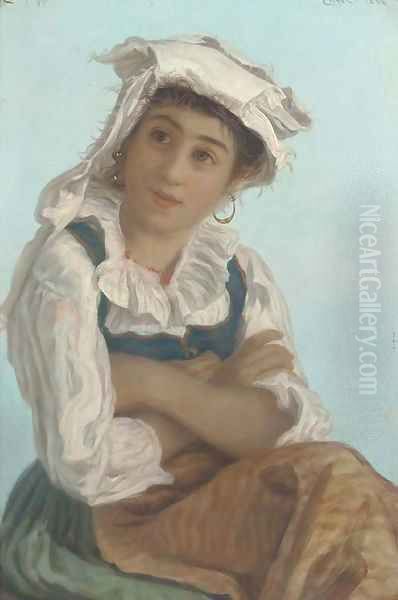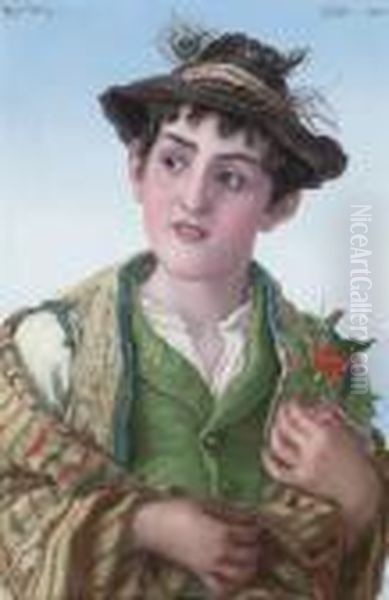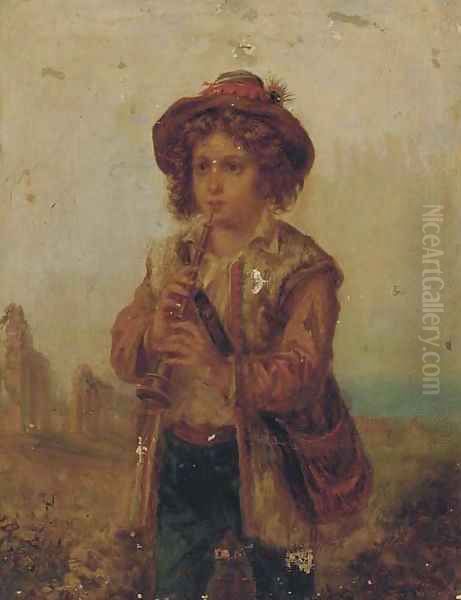Adriano Bonifazi stands as an intriguing figure in late nineteenth-century Italian art. Born in Naples in 1858 and passing away in Rome in 1914, his artistic career flourished primarily between 1875 and the mid-1890s. Though perhaps not as widely celebrated today as some of his contemporaries, Bonifazi carved a distinct niche for himself, specializing in depictions of Italian rural life, particularly featuring young women and children in traditional costumes. His work found particular favour not just within Italy, but significantly within the British art market, catering to a Victorian fascination with the picturesque and seemingly timeless traditions of the Mediterranean.
Early Life and Roman Beginnings
Details surrounding Adriano Bonifazi's early life and artistic training remain somewhat scarce. Born in the vibrant cultural hub of Naples in 1858, a city renowned for its own rich artistic traditions, it is plausible he received some initial exposure or training there. Naples was home to influential figures like Domenico Morelli and Filippo Palizzi, whose realist tendencies and focus on local life might have provided an early, if indirect, influence. However, the documented record places Bonifazi as active in Rome from 1875 onwards.
Rome, by this time the capital of a unified Italy, was a magnet for artists from across the peninsula and beyond. The Accademia di San Luca remained a central institution, though many artists also worked within independent studios or informal circles. Whether Bonifazi formally enrolled in the Accademia or studied under a specific master in Rome is not clearly documented. However, his arrival in the city marked the true beginning of his professional career, establishing the geographical and thematic focus that would define his output for the next two decades.
Thematic Focus: Idyllic Visions of Rural Italy
Bonifazi's artistic identity is inextricably linked to his chosen subject matter: the people and landscapes of rural Italy. He developed a reputation for charming genre scenes and portraits, often featuring young girls and children adorned in the distinctive traditional clothing of various regions. His canvases frequently transport the viewer to the countryside surrounding Rome, including areas like Latium, the Sabine Hills, and Subiaco, as well as further afield to places like Capri, Lucca, Siena, and Cascina.

His paintings often depict simple, everyday activities: a girl spinning wool, children playing, a peasant resting, or figures engaged in quiet contemplation. Works like Peasant Boy From Capri exemplify this focus. These are not generally scenes of harsh labour or social critique, which preoccupied some realist painters associated with the Verismo movement, such as Francesco Paolo Michetti. Instead, Bonifazi tended towards a more idealized and picturesque representation of peasant life, emphasizing its perceived simplicity, innocence, and connection to tradition.
The recurring motif of young women and children dressed in elaborate regional costumes was central to his appeal. These garments, with their specific colours, fabrics, and adornments, were rendered with care and detail, serving not just as clothing but as markers of cultural identity and authenticity. Titles like Abbate Girls and Fisherman's Son point directly to this focus on youthful subjects often defined by their social roles or regional origins within these idyllic settings.
Artistic Style: Realism with a Commercial Sensibility
Bonifazi worked predominantly within a realist framework, characteristic of much academic and popular painting in the latter half of the nineteenth century. His style is generally marked by clear drawing, careful modelling of forms, and a relatively smooth finish. He paid close attention to the textures of fabrics, the details of costumes, and the specific features of his models, aiming for a convincing representation of the visible world.
His realism, however, was often tempered by a degree of sentimentality and idealization. The expressions on his figures' faces are typically pleasant, serene, or gently melancholic, rather than conveying deep psychological complexity or hardship. The compositions are usually straightforward and balanced, focusing attention on the central figure or group. His colour palette often employed warm, earthy tones appropriate for sunlit Italian scenes, combined with the vibrant colours found in the traditional costumes he meticulously depicted.
While one source mentions a possible connection to the Venetian school, this seems unlikely to reflect a dominant stylistic influence in terms of light and atmospheric effects, which characterized painters like Giacomo Favretto or Ettore Tito. Bonifazi's style appears more aligned with the Neapolitan and Roman traditions of detailed genre painting. His approach emphasized narrative clarity and descriptive detail over painterly bravura or atmospheric suggestion, aligning well with the tastes of a market seeking easily understandable and aesthetically pleasing images of Italian life. This focus on "typicality" and "purity," as noted in the provided information, was a conscious strategy aimed at the foreign market's appetite for authentic, yet romanticized, Mediterranean scenes.
Representative Works and Recurring Motifs

While a comprehensive catalogue raisonné may be lacking, several works capture the essence of Bonifazi's output. Peasant Boy From Capri is frequently cited, showcasing his interest in regional types and youthful subjects. Other titles that appear in auction records and collections give further insight: The Young Spinner, Feeding the Doves, An Italian Beauty, Contemplation, A Neapolitan Water Carrier, and various portraits simply titled Roman Girl or similar descriptions.
These titles reinforce the recurring themes: solitary figures, often female, engaged in simple domestic or pastoral activities, or presented as portraits emphasizing their regional attire. The element of "attentiveness" or "contemplation" appears frequently, suggesting quiet moments captured from everyday life. The focus remained consistently on the human figure within a loosely defined rural or domestic setting, with landscape elements usually serving as a backdrop rather than the primary subject.
The work mentioned as Child with smallpox (Bambino col vaiuolo) stands out as potentially deviating from the generally picturesque themes, hinting at a capacity for depicting less idealized aspects of life, perhaps aligning more closely with the social realism explored by artists like the Neapolitan Antonio Mancini in some phases of his career, or the British painter Luke Fildes. However, without viewing the specific work, it's difficult to ascertain its overall tone and intent within Bonifazi's broader oeuvre.
Success in the British Market
A key aspect of Bonifazi's career was his significant success with British collectors and galleries. The provided information highlights his frequent exhibitions in London, listing venues such as the New British Institution, Christie's, Masonic & Sons, and the Everard Gallery. This transatlantic appeal was not unique, as many Italian artists found lucrative markets abroad, particularly in Britain and America, during this period. Artists like Giuseppe De Nittis and Giovanni Boldini achieved international fame, though often by relocating and adapting their styles.
Bonifazi's success in Britain can be attributed to several factors. The Victorian era saw a sustained interest in Italy, fuelled by the legacy of the Grand Tour, literature, and a romantic perception of the country as a repository of classical beauty and unspoiled folk traditions. Bonifazi's paintings, with their detailed depictions of colourful costumes and charming peasant life, perfectly matched this idealized image. They offered a picturesque counterpoint to Britain's own rapidly industrializing society.

Furthermore, his focus on children and young women tapped into a sentimental streak prevalent in Victorian art and culture. Genre scenes featuring children were popular, and Bonifazi's Italian subjects offered an exotic yet accessible variation on this theme. Compared to the grand historical or mythological canvases of leading British academicians like Frederic Leighton or Lawrence Alma-Tadema, Bonifazi's smaller-scale genre works were likely more affordable and suitable for domestic display, appealing to a growing middle-class collector base. His "simple style" and focus on "typicality" made the works easily understandable and appreciated.
Contemporaries and Artistic Milieu
Adriano Bonifazi operated within a vibrant and diverse Italian art scene. In Rome, where he was primarily based, artists like Pio Joris and Enrico Tarenghi also explored genre scenes, often with an Orientalist flavour or focusing on Roman popular life. Cesare Biseo was another contemporary known for his Orientalist themes. While Bonifazi focused on Italian rural subjects, the underlying interest in ethnographic detail and picturesque representation connected his work to broader trends.
His Neapolitan origins connect him to a powerful regional school. Although his style differed from the dramatic intensity of Domenico Morelli or the later, more experimental work of Antonio Mancini, the Neapolitan tradition of realism, particularly seen in the works of the Palizzi brothers (Filippo and Giuseppe) and later genre painters like Vincenzo Caprile, provides a relevant context. These artists shared an interest in depicting local life and types with fidelity.
Looking more broadly across Italy, the Macchiaioli movement in Florence had already challenged academic conventions with its emphasis on capturing light and form through patches ('macchie') of colour, though their influence seems minimal on Bonifazi's tighter style. In Venice, artists like Giacomo Favretto and Ettore Tito were masters of capturing the light and life of their city in vibrant genre scenes, stylistically distinct from Bonifazi's Roman and Southern Italian focus. The international success of figures like Giovanni Boldini and Giuseppe De Nittis, who embraced Parisian modern life, also contrasts with Bonifazi's more traditional, localized subject matter.
A Career Concluded: The Mid-1890s Turning Point
One of the intriguing aspects of Bonifazi's biography is the apparent conclusion of his active artistic career around the mid-1890s, nearly two decades before his death in 1914. The reasons for this cessation remain speculative. The provided text notes his limited participation in major Italian exhibitions in the later part of his active period (e.g., only two works in the 1893 national exhibition, and mentions of exhibitions primarily in 1883 and 1886), which might suggest a gradual withdrawal or a focus on the more reliable foreign market accessed through dealers rather than large public salons.

Several factors could have contributed to this winding down. Artistic tastes were evolving rapidly in the 1890s. The rise of Symbolism, Divisionism (in Italy), and Post-Impressionism internationally began to challenge the dominance of academic realism and picturesque genre painting. It's possible that the market demand for Bonifazi's specific style, while strong for a time, began to wane as newer artistic trends gained prominence.
Personal factors, such as health issues or a shift in interests, cannot be ruled out, although no specific information supports this. Economic fluctuations could also have impacted the art market. Perhaps the very success of his formula led to a sense of creative exhaustion, or maybe he achieved a level of financial security that reduced the imperative to produce and exhibit constantly. The mention of Attentiveness dated 1876, possibly a literary or philosophical piece, hints at potential interests beyond painting, though this remains highly speculative and unconfirmed as relating to his artistic output. Whatever the reason, his period of significant artistic production appears concentrated in the two decades from 1875 to roughly 1895.
Later Life and Legacy
Following the apparent end of his painting career in the mid-1890s, Adriano Bonifazi lived for almost another twenty years, passing away in Rome in 1914. Information about this later period of his life is scarce, suggesting a retreat from the public eye of the art world.
Bonifazi's legacy is that of a skilled and successful painter within a specific, popular genre of late nineteenth-century art. He was not a major innovator who radically altered the course of art history, nor did he engage deeply with the social or political turmoil of his time through his work in the manner of some Veristi. However, he excelled at creating well-crafted, appealing images that captured an idealized vision of Italian rural identity.
His paintings serve as valuable documents of regional costumes and offer insight into the tastes of the international art market, particularly in Britain, during the Victorian era. They represent a particular strand of realism focused on the picturesque, the typical, and the sentimental. While perhaps overshadowed by artists who pursued more avant-garde paths or tackled grander themes, Adriano Bonifazi remains a noteworthy figure for his consistent dedication to his chosen subject matter and his ability to connect with a significant audience beyond Italy's borders. His work continues to appear at auction, appreciated for its charm, technical competence, and nostalgic evocation of a bygone Italy.
Conclusion: A Painter of Place and People
Adriano Bonifazi navigated the art world of the late nineteenth century by specializing in a genre that held considerable appeal both domestically and internationally. His depictions of Italian peasants, particularly young women and children in traditional dress, offered a romanticized yet detailed glimpse into rural life. Working in a competent realist style, he catered effectively to market demands, finding particular success among British collectors fascinated by the perceived authenticity and picturesque beauty of Italy. While his career appears to have concluded relatively early, and he remains a less-studied figure compared to major contemporaries, his body of work stands as a testament to his skill and provides a charming visual record of regional Italian culture as seen through the lens of a commercially astute artist. His paintings remain appreciated for their aesthetic qualities and their ability to evoke the enduring allure of the Italian countryside.